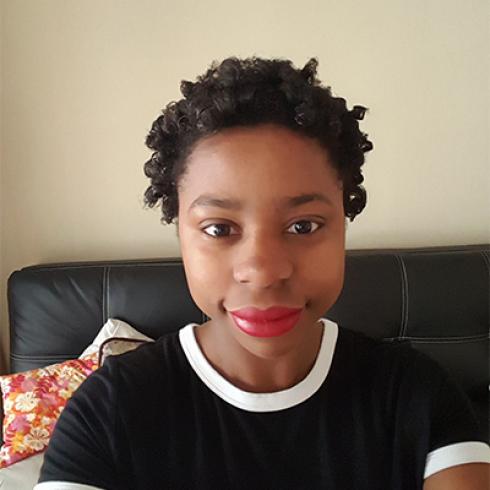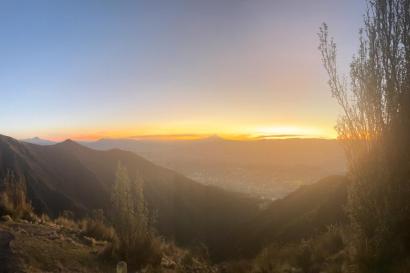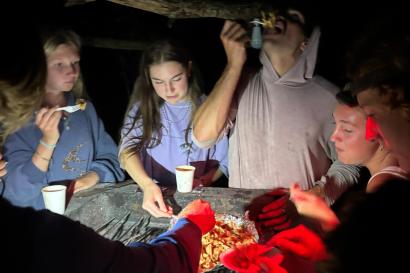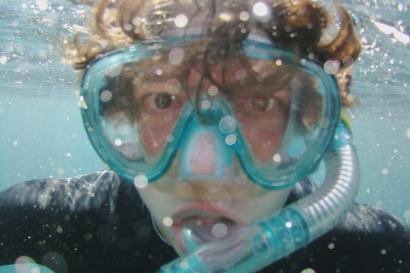Sleeping near the ocean is very difference from sleeping in Tiputini. In Tiputini, I was lulled to sleep by the sounds of the forest. Frogs and insects harmonized under the mood and brought the forest to life, even late at night. It was soothing, and I would quickly fall asleep. However, near the ocean where the salt water burns your insides, it made different sounds. The waves crash onto the beach, then make a quiet retreat only to return later. Crickets can be heard rubbing their legs together and the breeze finds its way through the window.
Marine Life was my second course and so far, the most difficult. Difficult due to content and being outside of my comfort zone. I would meet the ocean for the first time. Swim in it. Live next to it. Study it. Search for its inhabitants and hopefully, learn how the swim.
The class started in Esmeraldas, a town on the coast. We stayed at a beautiful hostel for 5 days and had our lectures in the dining area. The cabins had about 8 beds, 1.5 baths and balconies overlooking the ocean. The lounge area had a ping pong table, fooseball table, a pool, hammocks and a deck with chairs. The beach stretched for a couple of miles in each direction.
The entire week we went whale watching. Every morning we’d meet for breakfast at 7 (it was always late) and then head to the ocean. Three humpback whale experts and Judith, my professor, instructed the class for the week and led the field work. Judith also brought along her 18-20 year old niece and her niece’s friend. The two boats we did field work in had two responsibilities: tissue sampling and acoustics gathering. Judith had a large rifle and a dart that she’d aim at the thick part of an adult humpback whale and shoot. If the shot was good, the dart would bob in the water with whale tissue. The acoustics boat would stop at a whale sighting, lower a hydrophone in the water and record the whale songs.
Our first day whale watching was the best day to introduce me to the ocean. I was on Judith’s boat, the sun was shining and the ocean was calm. My classmates quickly spotted whales in the distance. I was ecstatic when I saw a humpback whale breach or blow water out of its blowhole. It was an amazing sight. When our boats drew close to them, maybe 5 meters away, I understood the magnitude of their size. A mother and calf were swimming by our boat, seemingly unfazed by our presence. I don’t know how else to describe their size, besides saying they are huge.
Watching Judith get her sample was intriguing and frightening. The boat was parallel to the whales, going steady so Judith could line up her shot. She aimed the rifle below the mother’s dorsal fin and fired. The dart hit the whale and popped off. I could see the hole left in the skin. I stared at the hole very uneasy; how could a shot that leaves a visible mark on a whale not hurt? Judith reassured us that the whale was fine-she did continue to swim as usual-and couldn’t feel the shot.
We collected a few more samples afterwards and then went for a bathroom break. Bathroom breaks on small boats can be fun, assuming the day is nice. Instead of finding a tree when you need to go in the forest, you put on a swimsuit and jump in the water. The biggest reason I went into the water, besides needing to go, was because my class was very supportive of my first time in the ocean and not being a good swimmer. Many people volunteered to teach me how to swim and helped keep me calm in the water. Judith vowed I’d know how to swim by the end of her class.
I had plenty of practice in the water in her class. After the week in Esmeraldas whale watching, we traveled as a class to the Galapagos Islands. My class was the last out of all the international students to arrive in Ecuador. My feed had pictures of San Cristobal from students already there, but it wasn’t the same as touching down in the plane. I screamed in excitement, “We’re finally here!” as I walked from the plane to a small airport. I was going to live in the Galapagos Islands. How many people can say that?
After orientation and lunch, our host families arrived to pick us up. My host family has 5 members: my host parents, Fernando and Sara; my host sister, Dome; my host brother, Kevin; and my youngest host sister, Arianna. My host mom and sister speak English. Actually, my host sister, Dome, speaks 3 languages: Spanish, English and Chinese. We have very stimulating discussions during dinner time.
There are dive shops on every block on the island where you can rent wetsuits. Not only do wetsuits keep you warm, they help you stay buoyant. No sinking in a wetsuit.
As comforting as this notion was, I remained uneasy about our next big expedition, Kicker Rock. Kicker Rock is a wonderful place to see turtles, fish, rays and sharks. Live sharks. I know sharks aren't as aggressive and scary as they're portrayed in movies, but my unfamiliarity with the ocean and fear of sharks made me very scared to go snorkel. I didn't know if the water would take me or the sharks.
Luckily, due to an assignment involving damselfish interactions with sea turtles and a trip to Tijeretas, a beautiful cove that is perfect for snorkeling, I had practice before hand in the water. Regardless, on the 45 minute boat ride to Kicker Rock, I couldn't help but think that something would go awry and I'd be left to the mercy of the fish. Besides one person, the rest of my classmates and Judith were diving.
As if the ocean sensed my fear, about 100 dolphins appeared on the scene after the divers descended. My high school mascot is a dolphin and I immediately forgot my fear of sharks to run to the bow of the boat and record the dolphins. The dolphins loved the boat and the captain was nice enough drive with them for us snorkelers.
They were common dolphins and their blowholes were larger than I thought. They would swim very close to the boat, jump out of the water and go under the boat. I was pressed against the railing as much as possible to get closer to them. The dolphins were jovial and plentiful. I'd look in another direction expecting to not see any and then they'd appear.
The dolphins helped calm me tremendously before snorkeling. I reasoned that they'd save me if I something happened (this probably isn't true but comforting nonetheless) and my snorkel guide was very patient.
On the first snorkel, we went through a channel made by the rocks. I had on a life jacket that I honestly believed was more for show than function. I saw a wide variety of fish, a few sea lions and sea turtles. They were swimming along maybe 5m underneath me. To see a sea turtle in the wild is amazing and nearly impossible to not do while in San Cristobal.
The highlight, however, of this expedition was the sharks. I'm not sure how, or when it happened, but seeing a shark rid me of my fear of sharks. My group was swimming back to the boat and a black-tipped shark appeared underneath us. If I knew how to dive with a snorkel I could’ve swam next to it.
I was failing my arms and shouting through my snorkel,”OMG it's a shark! It's a shark! Look at it!” With all the commotion I was making I was sure that shark knew we were there but it completely ignored us. Another black-tipped shark appeared after it.
Swim with sharks has been checked off my bucket list.
Now that I knew first hand that A) a wetsuit is sufficient to keep one floating in the ocean, and B) sharks don't care about humans, I felt more confident and comfortable in the water. For the 2nd snorkel trip, I went in sans life jacket and swam away from the guide looking for sharks. There is no better feeling than being able to face your fear and conquer it.
Currently, different students give me swim lessons on Playa Mann, a beach across the street from campus dominated by sea lions. I've learned how to float, swim with my head above water, handle the waves and tread. I'm not the best swimmer, but I can finally say that I can swim. Once I can tread for longer than 30 seconds, I'll be able to swim further out with my classmates. Next month, I’m going on a discovery dive. How many people can say they dove in Galapagos?
I arrived in Ecuador afraid of the water and it's creatures. I'm going to leave Ecuador with a new perspective, no longer afraid and vulnerable. You may come to Galapagos not knowing how to swim, but you leave Galapagos as if you were born in the water.

Tony Harris
<p>I attend Loyola University Chicago and am majoring in environmental science with a chemistry minor. When I’m not studying, I’m planning events and handling communications for the Student Environmental Alliance club. This has included cultivating previous journalism experience into scientific literature or publications. I try to keep busy with internships and campus events.</p>
<p>Besides academics, I enjoy being with friends and unwinding with video games, a book or TV. My favorite games are multiplayer and I binge watched Orange is the New Black in two days. I love being out in nature and try to go on adventures.</p>








